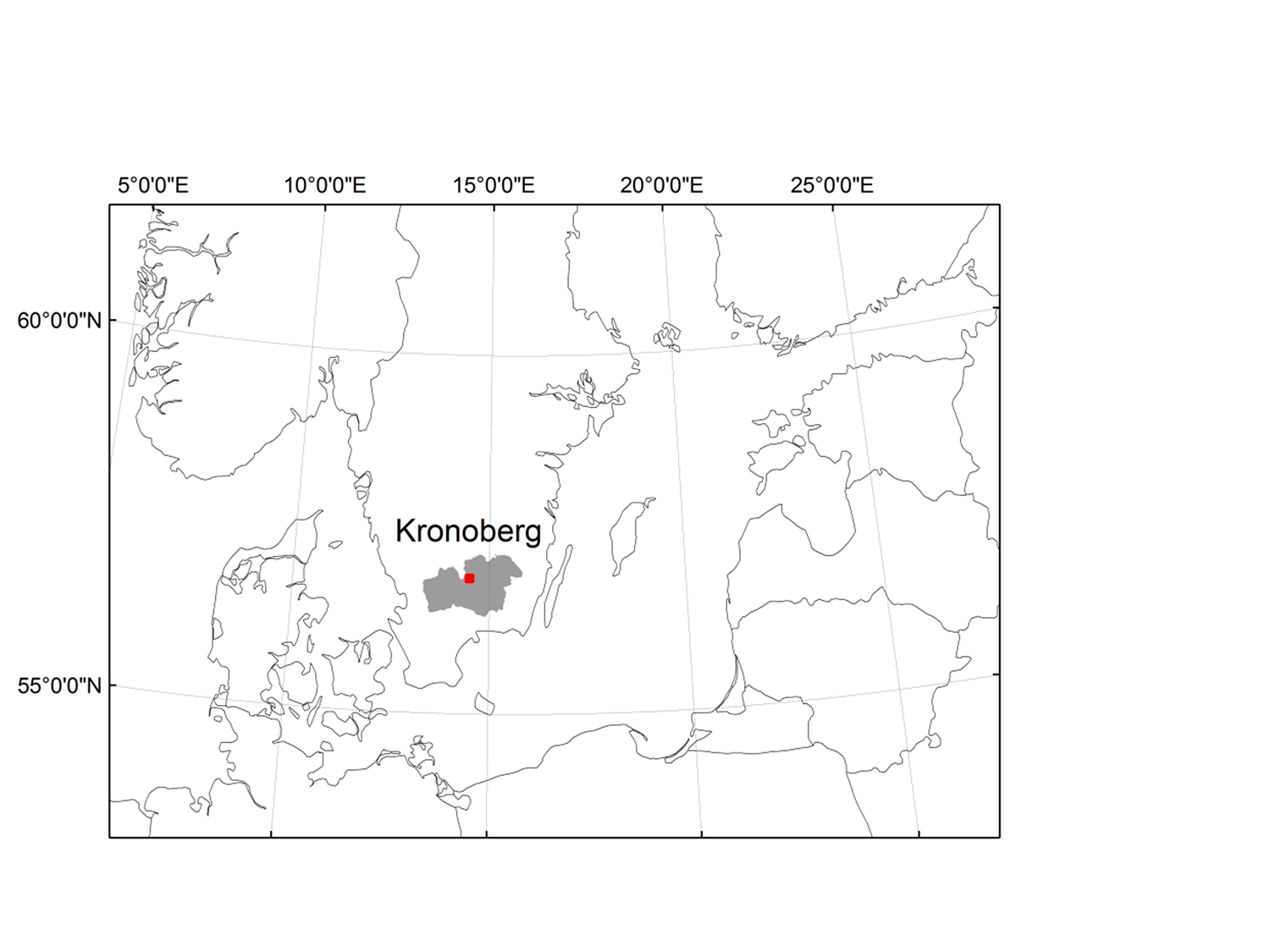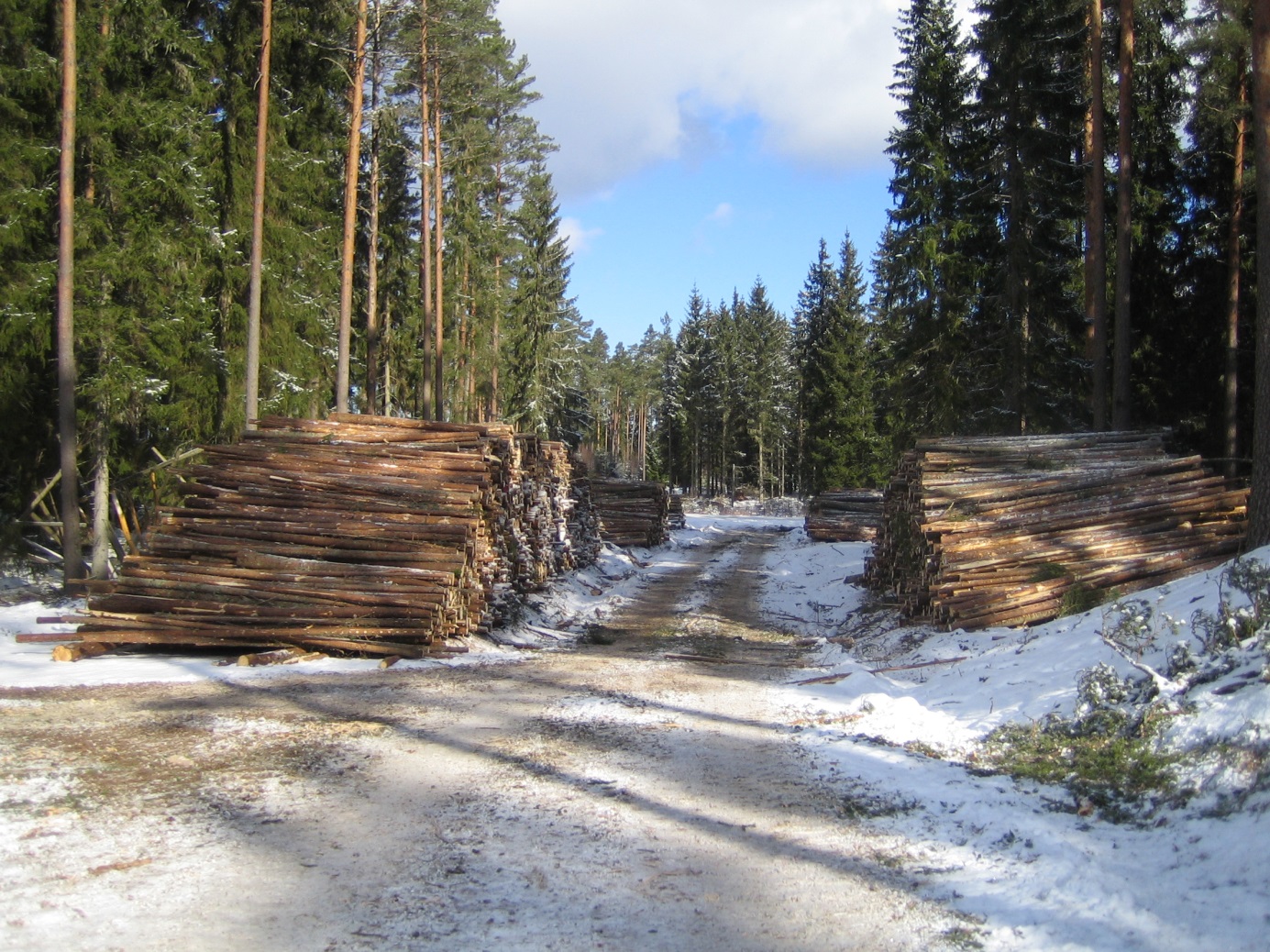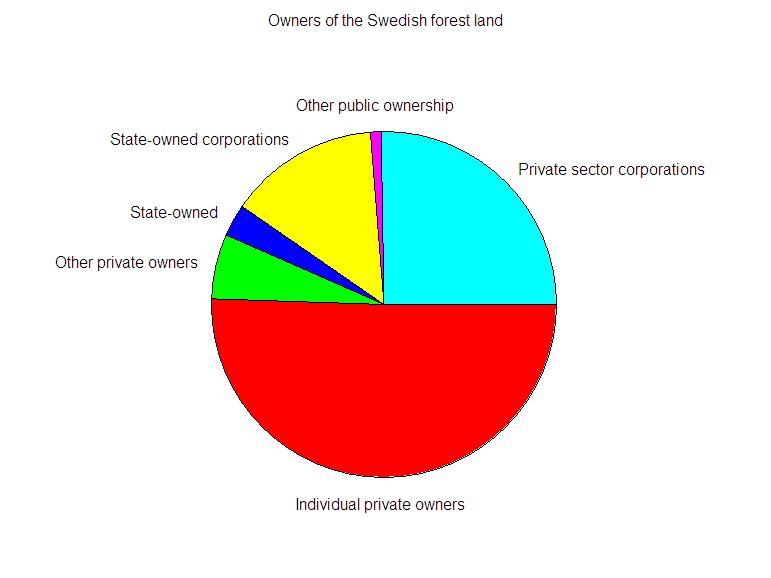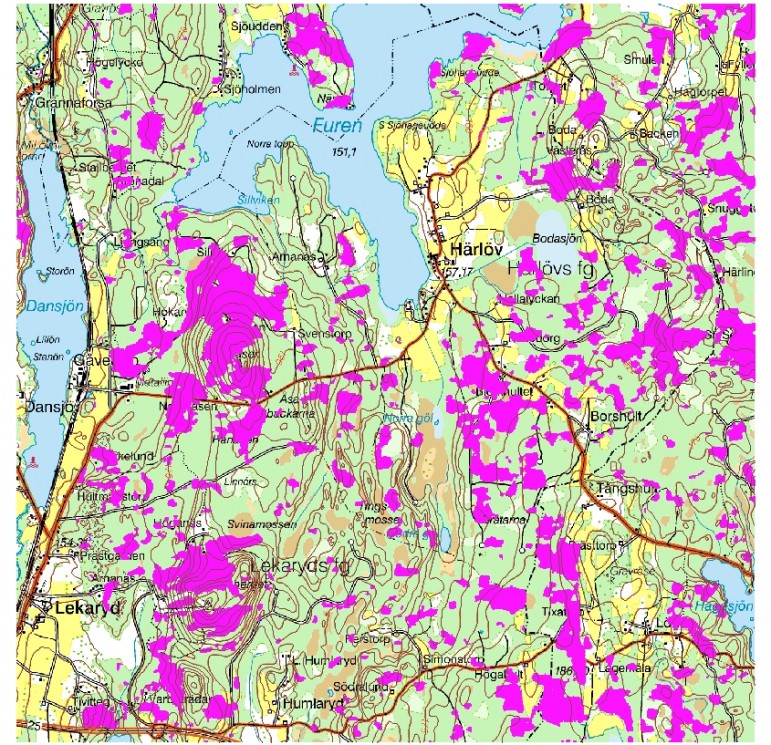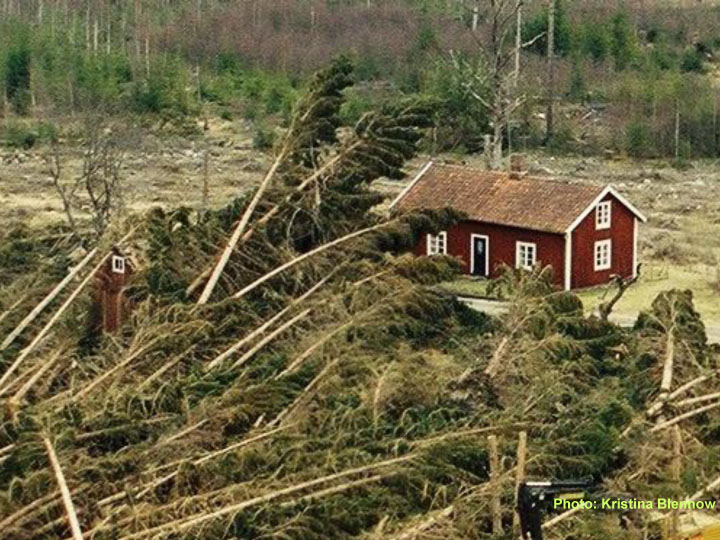General information about case study
Kronoberg County is located in southern Sweden and is situated at the transition zone between the northern hemisphere boreal zone and the mid-Europe deciduous forest zone Figure 1.
Current climate, climate change scenarios and soils
The climate of Kronoberg County is temperate and fairly continental with a substantial temperature amplitude. The average annual temperature was 6.1 °C for the period 1961-1990 and 7.0 °C for the period 1991-2008 and the precipitation was 753 mm/year for the period 1961-1990 and 835 mm/year for the period 1991-2008. The evaporation for the period 1961-1990 has been estimated to 425 mm/year. (Johnell et al. 2010). According to an ensemble of climate scenarios the annual average temperature and precipitation of Kronoberg County can be expected to increase by 4-5 °C and 17%, respectively, until the end of the present century compared to the period 1961-1990 (Johnell et al. 2010).
The climate for the area used for computer simulations in MOTIVE (Figure 1) depicts a distinct increase in temperature (Figure 2) but no distinct change in precipitation until the end of the present century (Figure 3) based on one climate model (CLM/ECHAM5) and one greenhouse gas emission scenario (A1B). The soil parent material in the area is mainly sandy and fine sandy tills (95%) and the dominating soil moisture class is mesic.
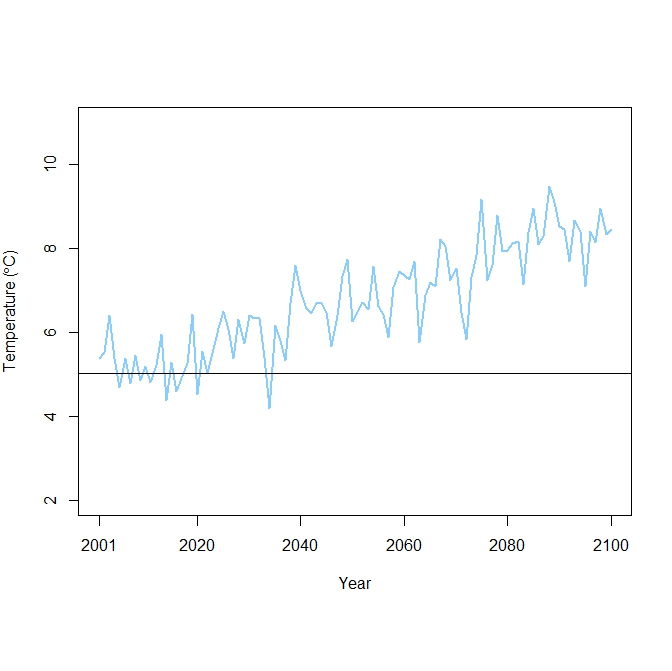
Figure 2: Mean annual temperature for the 21st century according to the climate change scenario A1B compared to the mean annual temperature for the control period 1961-2000 (black line) for the area used for computer simulations as provided within the MOTIVE project (based on CLM/ECHAM5 data, for more information please see MOTIVE D2.2 Climate and land-use data).
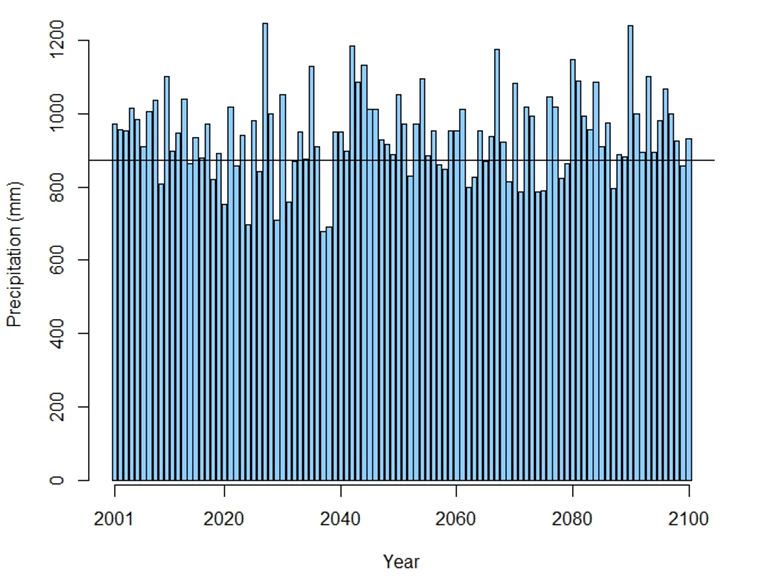
Figure 3: Annual precipitation for the 21st century according to the climate change scenario A1B compared to the precipitation for the control period 1961-2000 (black line) for the area used for computer simulations as provided within the MOTIVE project (based on CLM/ECHAM5 data, for more information please see Zimmermann 2010, and MOTIVE D2.2 Climate and land-use data).
Forests in Kronoberg County
The forested landscape of Kronoberg County has been shaped by human activity. The species composition and forest structure over 3000 years has transformed from mixed deciduous forest to coniferous forest (predominantly consisting of Norway spruce and Scots pine) and has been most rapid during the past 150 years (Lindbladh et al. 2000). It is primarily the result of human activity (Nilsson 1997). From the beginning of the 18th century until the end of the 19th century, forest land was converted to farm land to support an increasing population (Ekelund & Hamilton 2001). A large part of these areas have during the latter part of the 20th century, been forested again. During this period the demand for forest products increased due to industrialization.
More than four fifths of Kronoberg County is forested today. Most of the forest consists of Norway spruce and Scots pine but also birch and other deciduous species are present (Figure 4). The forest is among the most productive in Sweden with an average site quality of 8.8 m3/ha and year.
The forest terrain is rich in heritage and nature values, many of which are dependent on the land-use and management activities. The deciduous forest is productive, holds high nature vales and is important for experiences and recreation for its owners as well as for the general public. Seventy-nine percent of the productive forest land is owned by approximately 14,000 private individuals (SFA 2009). With few exceptions, the size of each land holding range from a few ha to a thousand ha.
An area of approximately 1,050 ha (56°57´N/14°40´E) holding 844 ha of forest is used as a case study area for simulations in MOTIVE (Figure 1). In this area in year 2000 the tree species composition by standing volume is Norway spruce (63%), Scots pine (19%), Birch (9%), and other mainly deciduous species (8%) (based on kNN Sweden 2000, Dept. of Forest Resource management, Swedish University of Agricultural Sciences). Six holdings of at least 5ha are found in the area.
Stakeholders
Kronoberg County has a range of public and private stakeholders in the forest. Public sector organisations include the Swedish Forest Agency (implementation of the forest policy and enforcement of the law), the Regional County Board of Kronobergs län (implementation of nature conservation policy, wind power and community planning at county level), major municipalities and their cooperation board (planning), Sveaskog (state forests), 6th form college for nature resource management, and the local museum (heritage). Private sector organisations include forest owner associations, local sawmills, nursery, timber, pulpwood and forest bio-fuel trading companies, forestry consultants, and large and small land owners. Non-governmental organisations include organisations for game management and consultancy and nature conservation representatives for the region.
Stakeholders and ecosystem services and benefits
Of the total land area of 849,000 ha of Kronoberg County, 81% is classified as productive forest land, 7% arable land, 7% mires, 4% grazing land, 2% urban land, 0.1% rock surface, 0.1% protected area excluding productive forest land, and 3% other land (SFA 2009). There are no national parks in the county but 10,441 ha is part of a nature reserve of which approximately half is productive forest land. The protected productive forest land in 2007 consists of coniferous forest (59%), broad-leaved forest (29%), mixed forest (9%), and felled areas (4%) (SFA 2009). In 2007 689 ha of land was classified as nature management areas, 33 ha of land as wildlife sanctuaries and 46 ha as culture reserves (SFA 2009). In 2008, 573 ha of productive forest land are habitat protection areas (SFA 2009). In the 1.050 ha of case study area 844 ha is productive forest land, 206 ha arable land. There is no nature reserve, but the area does include 3 ha of protected mixed coniferous forest.
The forest provides a wide range of services and benefits to its owners as well as to the general public. The harvested forest provides raw material for the forestry industry and is used for timber, pulpwood and forest bio-energy. The forest landscapes of Kronoberg County are important for recreation and activities such as berry and mushroom picking (Sandell & Sörlin 2008). Hunting rights belong to the land-owner, unless they are leased out. The forest owner culture has been characterised by Törnqvist (1995) as a rural type of self-employer lifestyle. At the heart of the lifestyle lies a high priority for independence. According to Hugosson & Ingmarsson (2004) the services from the forest to land-owners may be classified into production of game, berries, mushrooms and forest grazing, nature-, culture-, water- and soil conservation, emotional ties, forestry tradition, challenge of silviculture, aesthetics, financial return and liquidity, and tax planning.
Ownership and governance/management structures
The idea of the Swedish forest as a national resource for sustained wood production motivated the formulation of a Swedish forestry legislation that was first enacted in 1903. Between the 1950s and early 1990s the main objective of the Swedish forestry policy was production of timber and wood in a silviculture system of even-aged forest stands with clear-felling as the primary means of harvesting (Ekelund & Hamilton 2001). Through the 1993 revision of the Forestry Act, the objective of maintaining biodiversity took equal priority with production objectives. Other public interests are also taken into account in the management of the forest. In the revision, regulations requiring private forest owners to deliver high quantities of timber and wood at low costs to the forest industry were relaxed (Stjernquist 2001). To a larger extent than before the revision, owners are able to influence the management of their forests. The clear-felling silviculture system is applied on almost all of the productive forest land. However, according to current regulations planting or measures for natural regeneration must have been completed by the end of the third year after felling (SFS 1979:429). Regeneration felling must not be carried out until the forest has reached a certain age. Forest certification systems have been developed to promote responsible use of forests. Owners wishing to follow the rules may certify their forestry on a voluntary basis. In Sweden a vast majority of the productive forest land is certified (www.pefc.se; www.fsc-sverige.org).
The Right of Public Access is part of the Swedish constitution and allows the general public to roam the land and to pick wild berries, mushrooms and flowers, regardless of land ownership (Bengtsson 2004). Approximately 50% of the 22.7 million ha of Swedish forest is owned by private individuals (Figure 5) (SFA 2009). Swedish private individual forest owners on average get approximately 12 % of the household income from their forestry (Mattsson et al. 2003), which indicates that they also have strong motivations for owning a forest other than the financial return.
In Kronoberg County 79% of the productive forest land is owned by 13,696 private individuals (Figure 6) (SFA 2009), of whom 37 % are females and 63% are males. Alltogether they own 11,643 management units. Sixty-four percent of these are locally owned, 29 % are owned by non-residents and 8 % partly by non-residents (SFA 2009). With few exceptions, the size of each land holding range from a few ha to a thousand ha.
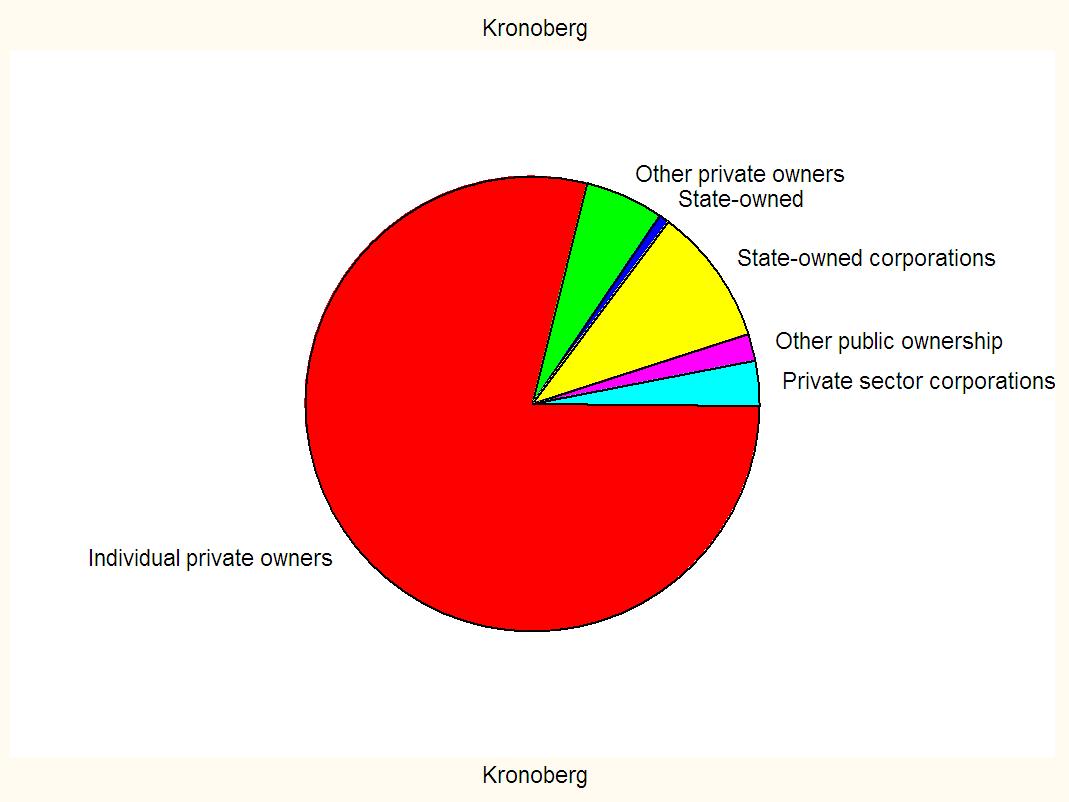
Figure 6. Fraction of Kronoberg county forest land owned by different owner categories in 2008 (SFA, 2009).
Are forests sensitive to climate change?
The distribution of forest tree species is expected to be affected by climate change which may have severe economic consequences (Hanewinkel et al. 2012). For example, the growth of Norway spruce is expected to suffer from water stress especially in south-eastern Sweden on sites with low water-holding capacity.[ 1] Studies assuming that the same tree species as today will be used in forestry indicate that the tree growth in Kronoberg County will in general increase under a warmer climate. Results from our simulations in the MOTIVE case study area, where we have applied business as usual forest management under both current climate and a warmer climate (A1B scenario), indicate that tree growth will increase by approximately 15% during the period 2001-2100 due to a warmer climate. The increase in growth is indicated to affect average standing volume (5%) and harvest volumes (15%) and to increase net incomes from forest operations. Due to increased growth, rotation periods will be shorter and forestry in general more intensive in terms of the number of forest operation activities per unit of time. The average number of activities per stand and year is indicated to increase by 6%, mainly in terms of final fellings and regenerations. For Norway spruce the average age at final felling under a warmer climate is indicated to reduce by seven years until the period 2071-2100. The effects of the changing climate on the forest will increase gradually which might affect also the provisioning of opportunities for hunting and recreation. Our simulation results show only small effects, however, on average moose habitat suitability index (Kurtilla et al. 2002) and recreation index (Lindhagen 2005) during the period 2001-2100.
At the same time climate change is expected to lead to increasing disturbances from extreme weather events, insect outbreaks, fungi etc. with consequences on services and benefits from the forest. While increasing growth might lead to higher financial return, the quality and or the quantity of the wood, and indeed the financial return, will reduce should insect outbreaks, wind damage or some other risk materialize. Furthermore, a changing climate might lead to effects that so far remain unidentified.
Wind damage to forests in southern Sweden has increased during recent decades (Gardiner et al., 2010). This is because of changes in the state of the forest as well as form a changing climate. Kronoberg County was the most extensively damaged county in a major wind damage event on 8 January, 2005, when damage occurred on 14.1% of its forest area (SFA 2006) (Figures SE-1 and SE-1). The wind damage was mainly done to Norway spruce (SFA 2006). More than a fourth of the forest area used for the MOTIVE simulation study was damaged during the 2005 wind damage event (based on data from the Swedish Forest Agency) (see Figure SE-1). Pervasive wind-related reduction in growth of the remaining forest during three years after the storm has recently been shown (Seidl & Blennow 2012). The growth reduction is of a magnitude similar to the total secondary damage incurred by spruce bark beetles during the corresponding period of time after the storm.
Which obstacles are limiting the implementation of adaptive management?
A major obstacle limiting the implementation of adaptive management is the forest owners’ personal perceptions of local effects of climate change. When forest owners believe in and see the effects of climate change, they are more likely to have taken adaptive measures. These two personal factors almost completely explain and predict forest owners´ adaptation to climate change (Blennow et al. 2012) The forest owners who have taken measures to adapt their forest management to climate change often see wind damage as the climate-change risk that increases the most (Blennow, 2012).
How did you make your conclusion(s)? Which tools and methods did you employ?
Our results are based on simulations of forest development with the Forest Time Machine (FTM) model and assessments of wind damage probabilities for the projected forest states using the WINDA-GALES model.
The FTM model is a forest management-unit simulator developed to support evaluation of forest management strategies at a landscape level (Andersson et al. 2005). The model uses empirical stand growth functions and different stand management programs can be assigned to the individual stands. The stand growth response to climate change is mediated by adjusting the site index according to modeling results from the FinnFor model (Kellomäki & Väisänen 1997; Matala et al. 2005). FTM outputs variables describing periodical states of the forest as well as flows of harvested wood and money.
In our FTM simulations we have applied stand management programs reflecting today’s management in terms of choice of tree species, initial spacing, thinning regime and rotation periods (business as usual management). We have applied adaptive stand management programs including shorter rotation periods and adjusted thinning regimes in combination with a species change at wind exposed locations. At these locations conifer tree species have been replaced with Silver and Downy Birch using natural regeneration at first regeneration occasion. The use of other deciduous tree species is expected to require additional game management and/or use of fencing at regeneration to mitigate browsing by moose and deer.
The WINDA-GALES model is an integrated system of models for assessing the probability of wind damage to forest stands building on the WINDA model (Blennow & Sallnäs 2004) and the GALES model (Gardiner et al. 2000). It provides a geographically explicit environment for standwise calculation of the probability of exceeding critical windspeeds for wind damage in a landscape. The calculations are sensitive to the stability of the forest as well as to the local wind climate and uses extreme value theory for the statistical calculations.
Gardiner, B.A., Peltola, H., Kellomäki, S., 2000. The development and testing of two models to predict the critical wind speeds required to damage coniferous trees. Ecol. Model. 129, 1–23.
Kellomäki, S. and Väisänen, H. 1997. Modelling the dynamics of the boreal forest ecosystems for climate change studies in the boreal conditions. Ecological Modelling 97: 121-140.
Matala, J., Ojansuu, R., Peltola, H., Sievänen, R. and Kellomäki, S. 2005. Introducing effects of temperature and CO2 elevation on tree growth into a statistical growth and yield model. Ecological Modelling 181:173-190.
